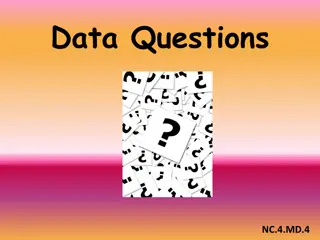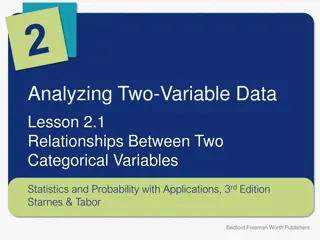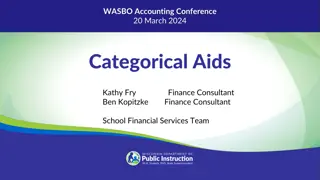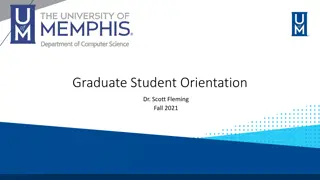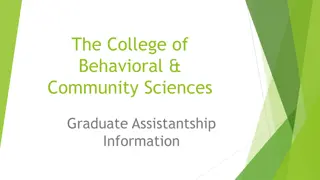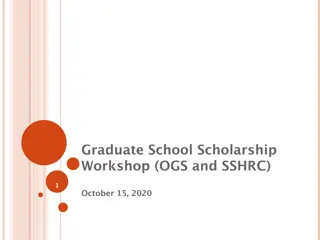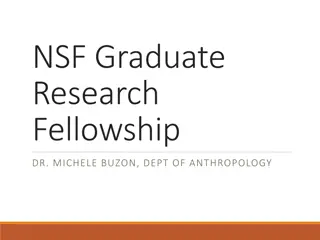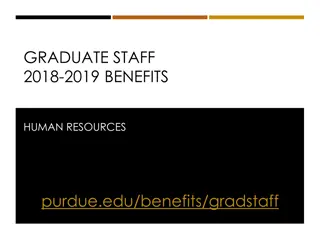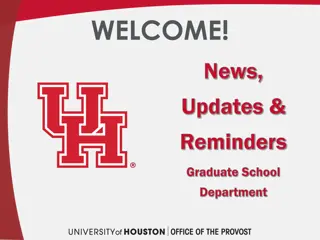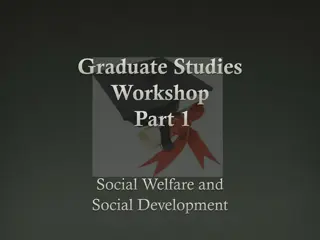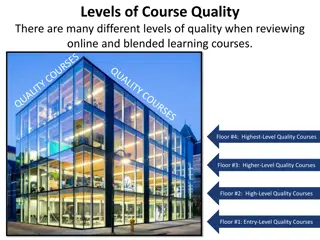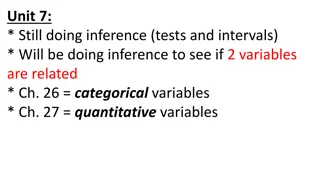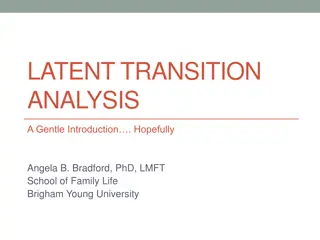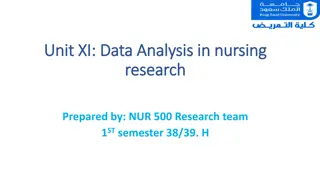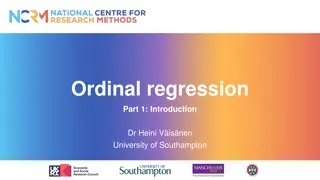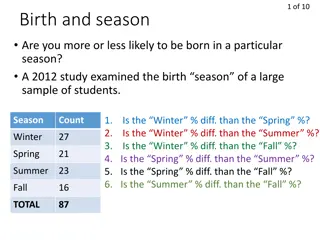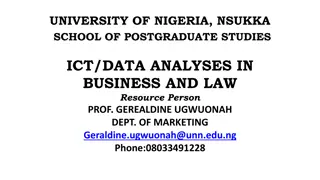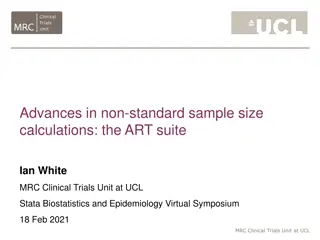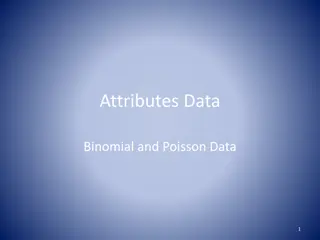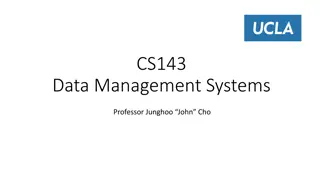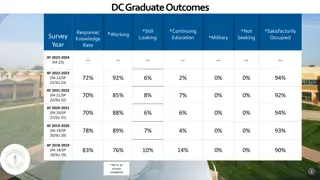Graduate Level Categorical Data Analysis Course
This PowerPoint presentation offers a comprehensive guide to teaching a first-semester course in Categorical Data Analysis at the graduate level. Covering key sections from Alan Agresti's textbook, the presentation includes real-data examples, software guidance, and solutions to exercises. The instructor shares personal insights to make statistics palpable, with SAS as the primary tool for computations. Additional resources and references enhance the learning experience.
Download Presentation

Please find below an Image/Link to download the presentation.
The content on the website is provided AS IS for your information and personal use only. It may not be sold, licensed, or shared on other websites without obtaining consent from the author. Download presentation by click this link. If you encounter any issues during the download, it is possible that the publisher has removed the file from their server.
E N D
Presentation Transcript
Categorical Data Analysis Categorical Data Analysis INTRODUCTION Dear instructor of graduate level Categorical Data Analysis, This powerpoint (ppt) presentation was created by me in order to teach a first-semester course in Categorical Data Analysis (CDA) based on Alan Agresti s textbook, Categorical Data Analysis, Third Edition, John Wiley & Sons, Inc., 2013 (ISBN: 978-0-470-46363-5, hardback). This ppt presentation covers most of the sections of chapters 1 6, 9, and 10. There is also a separate chapter , Ch. M (Multigraph), independent of Agresti s textbook which covers the multigraph representation of hierarchical loglinear models. Finally, Ch. S (Statistical Software) briefly describes the use of SAS, SPSS, and R in analyzing categorical data. There is some material in Agresti s book which I have left out of my ppt slides, and there is some material that I have included in the slides that does not appear in Agresti s book. Of course, one may edit the ppt slides to suit one s own preferences for the course.
INTRODUCTION, continued What has worked well in my classes is to provide the student with the ppt slides electronically ahead of the lecture. Those who wish can print the slides before the lecture so that they can make notes on the paper copy during the lecture. One can print up to 8 slides on one side of a sheet of paper. Alternatively, students can follow the slides on their computer during lecture. For some of the real-data examples I have provided personal stories about my experience with the given data or example. Students have found this very interesting. I think it helps to give them the sense that statistics is real or palpable in real world applications. SAS is the primary statistical software that is presented and used throughout the ppts to carry out computations. An introduction to SAS is given in chapter 2. Solutions to the chapter SUMMARY EXERCISES are provided in a WORD document.
There is a great deal of information about the book at: www.stat.ufl.edu/~aa/cda/cda.html At this website one can find, in addition to this ppt presentation, discussion of software, solutions to selected exercises, SAS code, etc. I hope that you will find this ppt presentation useful. I welcome feedback. Best wishes for a high probability of success. H. J. Khamis, Ph.D., P.Stat., FASA Director and Professor Emeritus, Statistical Consulting Center Professor Emeritus, Boonshoft School of Medicine Wright State Univeristy Dayton, OH. harry.khamis@wright.edu 3
Most of the references given in these ppt slides can be found in the References list at the back of Agresti s book. When a reference is given in these slides that is not contained in Agresti s reference list, the full citation will be provided at the location of the reference. The references for chapter M (Multigraph) are given at the end of chapter M. Now, let s begin our journey. 4
CONTENTS Chapter 0.5 INTRODUCTION, CONTENTS Chapter 5 5.1 5.2 LOGISTIC REGRESSION Logistic regression parameters Inference for logistic regression CONCLUSION SUMMARY EXERCISES Chapter M MULTIGRAPH CIG review Graphical models Generator multigraph Maximum spanning tree Decomposability Factorization Fundamental conditional independencies Collapsibility conditions Real data examples CONCLUSION SUMMARY EXERCISES CHAPTER M REFERENCES Chapter 1 1.1 1.2 1.3 1.4 1.5 DISTRIBUTIONS Levels of measurement Distribution theory Statistical inference for categorical data Inference binomial parameter Inference multinomial parameters CONCLUSION SUMMARY EXERCISES Chapter 6 6.1 6.2 6.3 6.4 LOGISTIC REGRESSION -- APPLICATION Model selection Model performance and diagnostics Predictive power Cochran-Mantel-Haenszel (CMH) test CONCLUSION SUMMARY EXERCISES Chapter 2 2.1 2.2 2.3 2.4 DESCRIBING CONTINGENCY TABLES Two-way contingency table Two-way contingency table -- association Partial and marginal contingency tables I x J contingency tables Introduction to SAS CONCLUSION SUMMARY EXERCISES Chapter 9 9.0 9.1 9.2 9.3 9.4 9.5 LOGLINEAR MODEL Motivating example Loglinear model for two-way tables Loglinear model for three-way tables Inference for loglinear models Loglinear model higher dimensions Loglinear model logistic regression model connection Motivating example -- revisit CONCLUSION SUMMARY EXERCISES Chapter S Statistical Software Introduction Two-way tables SAS Two-way tables SPSS Two-way tables R Multi-way tables SAS Multi-way tables SPSS Multi-way tables R Chapter 3 3.1 3.2 3.3 3.4 3.5 INFERENCE FOR TWO-WAY TABLES Confidence interval estimation Testing independence in two-way contingency tables Following up chi-squared tests Ordinal variables Small-sample inference for contingency tables CONCLUSION SUMMARY EXERCISES Chapter 10 10.0 10.1 10.2 LOGLINEAR MODEL -- APPLICATION Fixed margins Collapsibility Model selection Motivating example -- revisit CONCLUSION SUMMARY EXERCISES Chapter 4 4.1 4.2 4.3 GLM GLM introduction GLM for binary data GLM for counts and rates CONCLUSION SUMMARY EXERCISES 5




